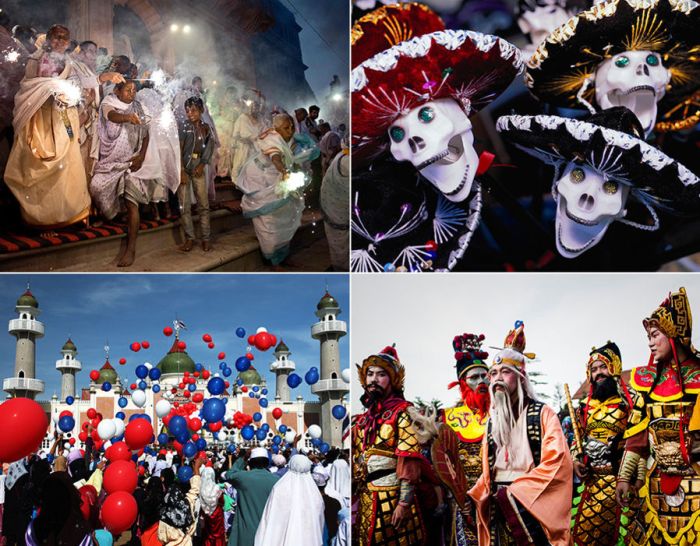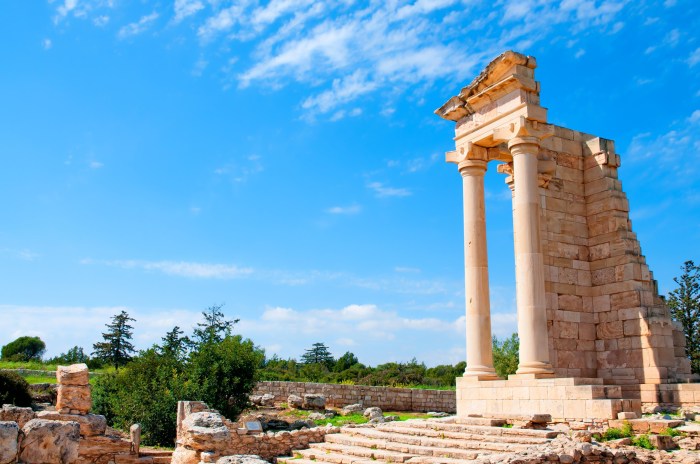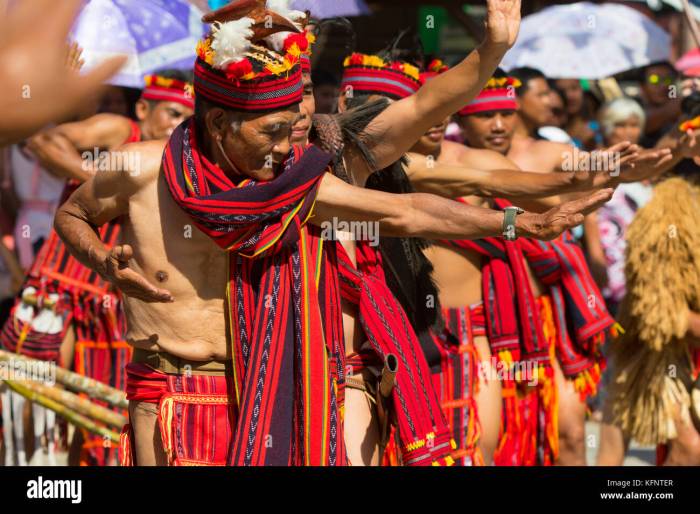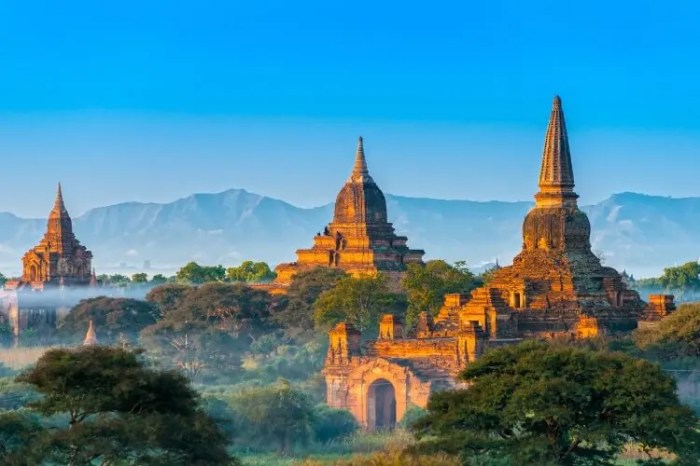
Heritage Sites in Asia Worth Visiting sets the stage for an enthralling exploration of Asia’s rich cultural and historical tapestry. From ancient temples echoing with spiritual resonance to majestic palaces whispering tales of emperors and empires, this journey unveils the remarkable diversity and enduring legacy of Asian heritage. These sites are not merely historical remnants; they are living testaments to the ingenuity, resilience, and artistry of countless generations, offering a profound connection to the past and a deeper understanding of the present.
This exploration delves into the unique characteristics of religious sites, architectural marvels, and breathtaking natural landscapes across the continent. We’ll examine specific examples, highlighting their significance and offering practical travel advice for those eager to experience these wonders firsthand. The journey will also touch upon luxury travel options, allowing for a curated experience that seamlessly blends exploration with refined comfort.
Heritage Sites in Asia: Heritage Sites In Asia Worth Visiting
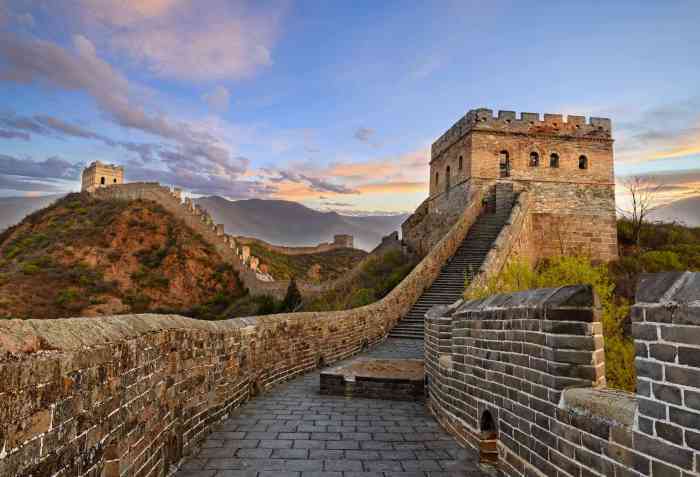
Asia, a continent brimming with ancient civilizations and vibrant cultures, boasts an unparalleled collection of heritage sites. From the towering temples of Angkor Wat to the serene beauty of the Taj Mahal, these locations offer a captivating glimpse into the rich tapestry of Asian history and the ingenuity of its people. Exploring these sites isn’t just about sightseeing; it’s about connecting with the past, understanding diverse traditions, and appreciating the enduring legacy of human creativity and resilience.
These places serve as powerful reminders of the interconnectedness of human history and the importance of preserving cultural heritage for future generations.These sites are worth visiting for a multitude of reasons. They offer a unique opportunity to witness architectural marvels, often built using techniques lost to time. Beyond the aesthetics, these sites provide invaluable insights into the social structures, religious beliefs, and artistic expressions of past societies.
Experiencing these places firsthand allows for a deeper understanding of the historical events and cultural influences that have shaped modern Asia, fostering a greater appreciation for the continent’s diverse heritage. Moreover, many of these sites are actively involved in community development and cultural preservation, providing economic opportunities and supporting local traditions.
Ancient Cities and Architectural Wonders, Heritage Sites in Asia Worth Visiting
Many Asian heritage sites are ancient cities that offer a window into the daily lives of people who lived centuries ago. These cities often feature remarkably preserved structures, revealing sophisticated urban planning and architectural techniques. For example, the ancient city of Mohenjo-daro in Pakistan, part of the Indus Valley Civilization, showcases a highly developed urban infrastructure with sophisticated drainage systems and standardized brick sizes, demonstrating a level of planning far ahead of its time.
Similarly, the ruins of Angkor Thom in Cambodia reveal the impressive scale and complexity of the Khmer Empire’s capital city, complete with temples, palaces, and public works. These sites offer a tangible connection to the past, allowing visitors to walk through the streets and imagine the lives of those who once inhabited these vibrant centers.
Religious and Spiritual Significance
A significant number of Asian heritage sites hold profound religious and spiritual significance, attracting pilgrims and visitors alike for centuries. The Taj Mahal in India, a breathtaking mausoleum built by Mughal emperor Shah Jahan to honor his wife, stands as a testament to the power of love and devotion. Its intricate marble inlay and symmetrical design represent the pinnacle of Mughal architecture and are deeply revered by people of all faiths.
Similarly, the Borobudur temple in Indonesia, a magnificent Buddhist monument, is a significant pilgrimage site, attracting thousands of visitors annually who come to appreciate its intricate carvings and spiritual atmosphere. These sites offer not only architectural beauty but also a deep understanding of the diverse religious traditions that have shaped Asian societies.
Natural Heritage and Cultural Landscapes
Beyond the architectural wonders, Asia also boasts numerous natural heritage sites that demonstrate the intricate relationship between humans and their environment. These sites often showcase unique ecosystems, stunning natural landscapes, and cultural practices that have developed in harmony with nature. The rice terraces of the Philippines, for instance, demonstrate the ingenuity of traditional farming techniques, where generations of farmers have carved terraces into mountain slopes to cultivate rice.
These terraces represent not only a sustainable agricultural practice but also a unique cultural landscape that reflects the deep connection between people and their environment. Similarly, the Ha Long Bay in Vietnam, with its thousands of limestone karsts and isles, showcases a stunning natural landscape that has inspired countless legends and artistic expressions. These sites highlight the importance of preserving both natural and cultural heritage for future generations.
Top 10 Heritage Sites in Asia

Asia, a continent of immense diversity, boasts a rich tapestry of history and culture reflected in its numerous UNESCO World Heritage sites. These locations offer glimpses into ancient civilizations, architectural marvels, and natural wonders that have shaped the region’s identity. Exploring these sites provides a profound understanding of Asia’s complex and fascinating past.
Ten Significant Asian Heritage Sites
The following table highlights ten significant Asian heritage sites, showcasing their location, brief descriptions, and evocative imagery. These sites represent only a small fraction of the incredible heritage found across the continent, each holding unique historical and cultural significance.
| Site Name | Location | Brief Description | Image Description |
|---|---|---|---|
| Angkor Wat | Cambodia | A massive stone temple complex, originally a Hindu temple dedicated to the god Vishnu, later transformed into a Buddhist temple. It is the largest religious monument in the world and a masterpiece of Khmer architecture. | A sprawling complex of intricately carved sandstone towers and structures, surrounded by a moat, bathed in the golden light of sunrise. The central tower, a towering symbol of Khmer power and artistry, dominates the scene. |
| The Great Wall of China | China | A series of fortifications built over centuries, connecting different sections of ancient Chinese states. It’s a symbol of Chinese strength and ingenuity, a testament to human perseverance and architectural ambition. | A long, winding wall snaking across rugged mountains and plains, punctuated by watchtowers and fortifications. The vastness of the structure and the scale of the landscape are powerfully emphasized. |
| Taj Mahal | India | An ivory-white marble mausoleum commissioned by Mughal emperor Shah Jahan to house the tomb of his favorite wife, Mumtaz Mahal. It is a breathtaking example of Mughal architecture and a symbol of eternal love. | A majestic, symmetrical building with intricate detailing and inlaid precious stones. The central dome is reflected in a calm pool, creating a visually stunning and harmonious scene. |
| Borobudur | Indonesia | A 9th-century Mahayana Buddhist temple, featuring three tiers representing the Buddhist cosmology. It is one of the greatest Buddhist monuments in the world, a testament to the sophisticated art and architecture of ancient Java. | A vast, tiered structure of stone, adorned with intricate bas-reliefs depicting scenes from the life of Buddha and Buddhist cosmology. The temple is nestled amidst lush green rice paddies. |
| Machu Picchu | Peru (South America, but historically connected to Asian trade routes) | A 15th-century Inca citadel, nestled high in the Andes Mountains. Its stunning location and sophisticated stonework are testaments to Inca ingenuity and engineering. While technically in South America, its historical connections to Asian trade routes warrant inclusion. | A breathtaking view of the city perched high on a mountain ridge, with terraced fields cascading down the slopes. The intricate stone structures blend seamlessly with the surrounding landscape. |
| Petra | Jordan (West Asia) | A city carved into sandstone cliffs, a significant trading center of the Nabataean civilization. Its stunning rock-cut architecture and intricate water systems are a testament to the ingenuity of this ancient culture. | A dramatic landscape of towering sandstone cliffs, with buildings, tombs, and water channels carved directly into the rock face. The rose-colored sandstone glows in the sunlight. |
| Kyoto’s Historic Monuments | Japan | A collection of temples, shrines, palaces, and gardens representing the pinnacle of Japanese traditional architecture and culture, reflecting centuries of cultural and artistic development. | A serene scene of traditional Japanese architecture, featuring meticulously maintained gardens, wooden temples with intricate details, and peaceful ponds. |
| Megalithic Sites of Gobekli Tepe | Turkey (West Asia) | A collection of monumental circular structures dating back to the Pre-Pottery Neolithic period, predating other known monumental architecture. Its discovery revolutionized our understanding of early human societies. | Immense, T-shaped pillars arranged in circles, showcasing sophisticated stonework and hinting at a complex social organization in a previously unexpected time period. |
| Ajanta Caves | India | Rock-cut cave monuments dating back to the 2nd century BCE to the 6th century CE. These caves contain remarkable examples of Buddhist art, including murals and sculptures. | A series of caves carved into a cliff face, adorned with vibrant murals depicting scenes from the life of Buddha and Buddhist mythology. The interior spaces are dimly lit, creating a mystical atmosphere. |
| The Forbidden City | China | The former imperial palace in Beijing, the largest palace complex in the world. It served as the home of emperors and their families for nearly 500 years and stands as a powerful symbol of Chinese imperial power. | A vast complex of red-walled buildings, surrounded by moats and walls. The intricate details of the architecture and the scale of the complex are breathtaking. |
Exploring Specific Heritage Site Categories
Asia’s rich tapestry of heritage sites encompasses a vast array of cultural and natural wonders, each possessing unique characteristics that reflect the region’s diverse history and environment. Understanding these distinctions allows for a deeper appreciation of the significance of these sites and the stories they tell. This section will delve into specific categories of Asian heritage sites, highlighting their architectural marvels and natural beauty.
Religious Heritage Sites in Asia
Religious sites across Asia showcase a remarkable diversity of architectural styles and spiritual significance. From the towering pagodas of Southeast Asia to the intricate mosques of the Middle East and the serene temples of the Himalayas, these structures are not merely places of worship; they are living testaments to centuries of faith, artistic expression, and cultural exchange. The grandeur of Angkor Wat in Cambodia, a massive stone temple complex dedicated to the Hindu god Vishnu, exemplifies the scale and sophistication achieved in religious architecture.
Similarly, the intricate carvings and towering minarets of the Jama Masjid in Delhi, India, reflect the artistry and engineering prowess of the Mughal empire. The serene beauty of the Kiyomizu-dera temple in Kyoto, Japan, with its wooden stage and stunning views, highlights the harmonious blend of nature and religious architecture. These sites offer a glimpse into the deep-rooted spiritual beliefs and artistic traditions of their respective cultures.
The materials used, the architectural styles, and the decorative elements all speak volumes about the beliefs and practices of the people who built and continue to use these sacred spaces.
Architectural Marvels in Ancient Cities and Palaces
Ancient cities and palaces across Asia stand as enduring testaments to the ingenuity and artistry of past civilizations. The meticulous planning and construction of these urban centers and royal residences reveal advanced understanding of engineering, urban design, and artistic expression. The Forbidden City in Beijing, China, with its vast scale and intricate layout, exemplifies the power and sophistication of the Ming and Qing dynasties.
The elaborate carvings and intricate details of the palaces within reveal a level of craftsmanship rarely seen elsewhere. Similarly, the ancient city of Petra in Jordan, carved into sandstone cliffs, showcases remarkable architectural feats and ingenuity in adapting to the challenging landscape. The ruins of Mohenjo-daro and Harappa in Pakistan, belonging to the Indus Valley Civilization, reveal a highly developed urban planning system thousands of years ago, including sophisticated drainage systems and standardized brick sizes.
These ancient sites offer invaluable insights into the social, political, and technological advancements of their respective eras. The scale and complexity of these projects highlight the organizational capacity and technological prowess of past civilizations.
Natural Heritage Sites in Asia
Asia’s diverse geography is home to a remarkable array of natural heritage sites, including towering mountain ranges, lush rainforests, and pristine coastlines. These sites not only offer breathtaking beauty but also provide critical habitats for a wide range of flora and fauna. The Himalayas, stretching across several countries, represent one of the most significant mountain ranges in the world, with its diverse ecosystems supporting unique biodiversity.
In contrast, the Komodo National Park in Indonesia is renowned for its unique dragon population and diverse marine life. The diverse landscapes of these sites represent the variety of ecosystems found across Asia, highlighting the importance of conservation efforts. Comparing the lush rainforests of Borneo (Malaysia, Indonesia, and Brunei) with the arid deserts of the Middle East illustrates the striking contrast in biodiversity and environmental challenges faced in different regions.
The preservation of these natural wonders is crucial for maintaining biodiversity, mitigating climate change, and ensuring the sustainable development of the region.
Exploring Asia’s heritage sites is an enriching experience that transcends mere sightseeing. It’s a journey into the heart of human history, a testament to the enduring power of culture and a profound connection to the past. Whether you’re captivated by ancient ruins, spiritual sanctuaries, or breathtaking natural beauty, Asia offers a treasure trove of experiences waiting to be discovered.
Remember to travel responsibly, respecting the local communities and preserving these invaluable sites for future generations to cherish. The memories made amidst these historical wonders will undoubtedly be among the most cherished of your travels.
Frequently Asked Questions
What is the best time of year to visit Asian heritage sites?
The ideal time varies depending on the specific location. Research the climate of your chosen sites to avoid monsoon seasons or extreme heat.
How much does it cost to visit these heritage sites?
Costs vary greatly depending on travel style, duration, and chosen sites. Budget accordingly for flights, accommodation, entrance fees, and local transportation.
Are there any safety concerns when visiting these sites?
Standard travel safety precautions apply. Research local customs, be aware of your surroundings, and consider travel insurance.
What language is spoken at these sites?
Languages vary widely. Learning basic phrases in the local language is helpful, but English is often spoken in tourist areas.
